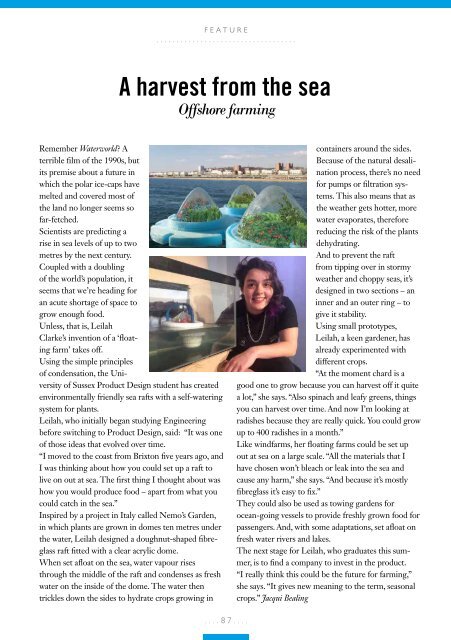Viva Brighton Issue #64 June 2018
Create successful ePaper yourself
Turn your PDF publications into a flip-book with our unique Google optimized e-Paper software.
FEATURE<br />
...................................<br />
A harvest from the sea<br />
Offshore farming<br />
Remember Waterworld? A<br />
terrible film of the 1990s, but<br />
its premise about a future in<br />
which the polar ice-caps have<br />
melted and covered most of<br />
the land no longer seems so<br />
far-fetched.<br />
Scientists are predicting a<br />
rise in sea levels of up to two<br />
metres by the next century.<br />
Coupled with a doubling<br />
of the world’s population, it<br />
seems that we’re heading for<br />
an acute shortage of space to<br />
grow enough food.<br />
Unless, that is, Leilah<br />
Clarke’s invention of a ‘floating<br />
farm’ takes off.<br />
Using the simple principles<br />
of condensation, the University<br />
of Sussex Product Design student has created<br />
environmentally friendly sea rafts with a self-watering<br />
system for plants.<br />
Leilah, who initially began studying Engineering<br />
before switching to Product Design, said: “It was one<br />
of those ideas that evolved over time.<br />
“I moved to the coast from Brixton five years ago, and<br />
I was thinking about how you could set up a raft to<br />
live on out at sea. The first thing I thought about was<br />
how you would produce food – apart from what you<br />
could catch in the sea.”<br />
Inspired by a project in Italy called Nemo’s Garden,<br />
in which plants are grown in domes ten metres under<br />
the water, Leilah designed a doughnut-shaped fibreglass<br />
raft fitted with a clear acrylic dome.<br />
When set afloat on the sea, water vapour rises<br />
through the middle of the raft and condenses as fresh<br />
water on the inside of the dome. The water then<br />
trickles down the sides to hydrate crops growing in<br />
containers around the sides.<br />
Because of the natural desalination<br />
process, there’s no need<br />
for pumps or filtration systems.<br />
This also means that as<br />
the weather gets hotter, more<br />
water evaporates, therefore<br />
reducing the risk of the plants<br />
dehydrating.<br />
And to prevent the raft<br />
from tipping over in stormy<br />
weather and choppy seas, it’s<br />
designed in two sections – an<br />
inner and an outer ring – to<br />
give it stability.<br />
Using small prototypes,<br />
Leilah, a keen gardener, has<br />
already experimented with<br />
different crops.<br />
“At the moment chard is a<br />
good one to grow because you can harvest off it quite<br />
a lot,” she says. “Also spinach and leafy greens, things<br />
you can harvest over time. And now I’m looking at<br />
radishes because they are really quick. You could grow<br />
up to 400 radishes in a month.”<br />
Like windfarms, her floating farms could be set up<br />
out at sea on a large scale. “All the materials that I<br />
have chosen won’t bleach or leak into the sea and<br />
cause any harm,” she says. “And because it’s mostly<br />
fibreglass it’s easy to fix.”<br />
They could also be used as towing gardens for<br />
ocean-going vessels to provide freshly grown food for<br />
passengers. And, with some adaptations, set afloat on<br />
fresh water rivers and lakes.<br />
The next stage for Leilah, who graduates this summer,<br />
is to find a company to invest in the product.<br />
“I really think this could be the future for farming,”<br />
she says. “It gives new meaning to the term, seasonal<br />
crops.” Jacqui Bealing<br />
....87....


















